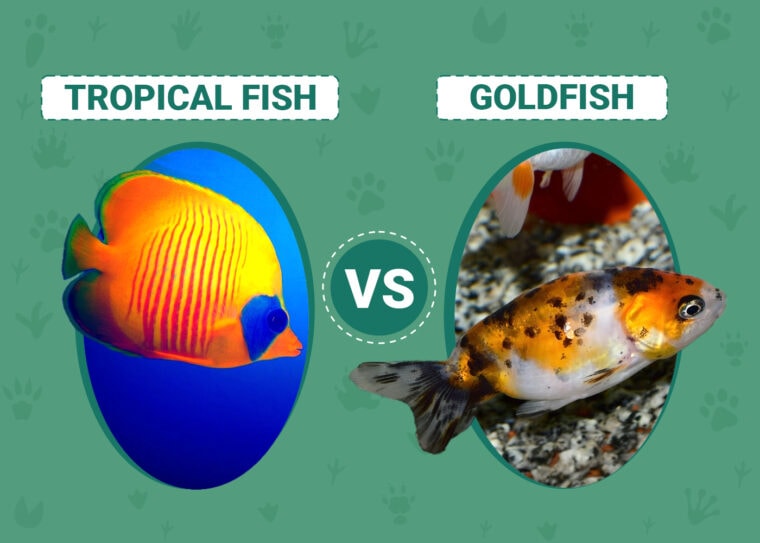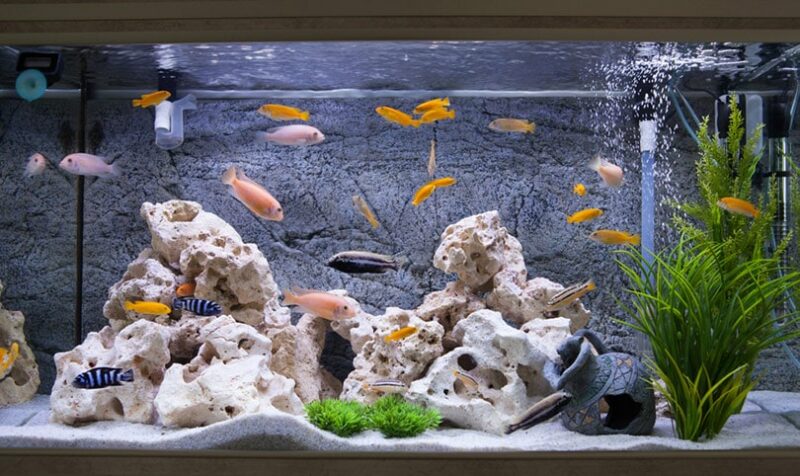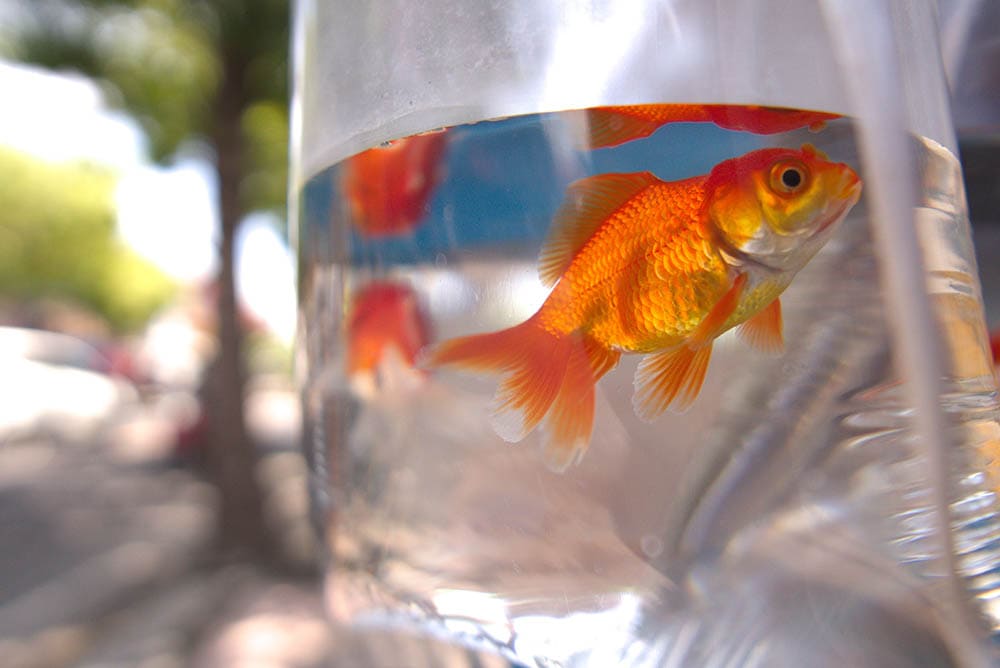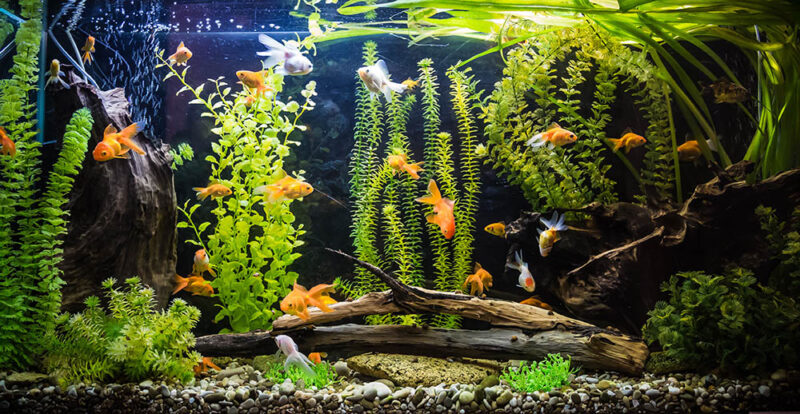
Setting up a fish tank is an exciting step to take as a fish enthusiast. You get to pick a tank, design it the way you like, and add beautiful fish of your choice. Many people start their new hobby with the popular goldfish. They’re hardy creatures that are inexpensive, easy to maintain, and have a long lifespan. Other people prefer tropical fish, such as Mollies or Cory Catfish, because they don’t require as much space, are cleaner, more colorful, and have a greater variety of species to choose from, differing in size, and shape.
There are many differences between tropical fish and goldfish, with the main one being their water temperature requirements. Goldfish thrive in cold water whereas tropical fish need warm water and therefore, the two species of fish cannot live together in the same tank. We’ll discuss the differences between the two so that you can make an informed decision and decide which one is right for you.
Visual Differences

At a Glance
Tropical Fish Overview

Tropical fish come from bodies of water near the equator and thrive in warmer water temperatures. They can be found in many different countries around the world, in seas, and freshwater or saltwater rivers, making them diverse, adaptable, and a great fish option for beginners. Tropical fish are colorful and captivating. They are typically happy to share their space with other tropical fish, but certain types can be aggressive and need to live on their own for the safety of other fish. A few popular tropical fish types for beginners are Mollies, Neon Tetra, Cory Catfish, Dwarf Gouramis, and Harlequin Rasbora.
There are over 1,800 tropical fish species being sold and traded throughout the world. With so many different species of tropical fish, it’s hard to offer definite sizes, weights, lifespans, and other specific information because they differ so much per species. One of the smallest tropical fish you can add to your tank is the Indonesian Superdwarf fish which has a size of 0.41 inches while the Paroon shark can reach 10 feet in length and are not a great tank option! Most tropical fish suited for your tank will be around 2.5 inches to 4 inches in size.
Temperament
Tropical fish cannot be placed under one umbrella with this one as their temperament ranges from peaceful and social, to aggressive, territorial, and reserved. Typically, the smaller the fish, the more social they are, and the larger, the more aggressive. However, this is not always the case.
A few social tropical fish types are Guppies, Neon tetras, Dwarf gourami, Rosy barb, Swordtail, Danios, and Bristlenose catfish which can be housed together without issues. More aggressive tropical fish types that tend to nip the fins of other fish are Tiger barbs, Serpae tetras, Blue tetras, and Skunk Botia. Some less aggressive fish that can be equally problematic are Silver Sharks and Angelfish as they eat smaller fish and should only be kept in tanks with fish of their size or bigger.
Appearance
Tropical fish boasts beautiful patterns and bright colors and are typically more attractive than cold-water fish. However, tropical fish can look incredibly different from each other with some covered in striking colors, such as the Discus fish, and others offering less variety such as the Platies that can be black in color.

Environment & Care
Many novice fish owners think that tropical fish are difficult to care for but that’s not the case. Due to tropical fish being so adaptable, you may find them easier to maintain and care for than goldfish. They don’t require as much space as goldfish do, they make less of a mess, and can live happily in a 10-gallon fish tank that has a temperature of between 71.6–78.8˚F.
The reason why some people shy away from tropical fish is that they require a reliable heater as these fish need a controlled temperature and environment to survive. If you live in an area that constantly has power outages, you might want to consider a goldfish or another cold-water fish instead. Other than a heater, you’ll also need lighting and a good filtration system.
Suitable for:
Tropical fish may be better suited for people with apartments or houses that don’t have enough space to keep a large fish tank. They’re also the perfect option for those that enjoy bright colors and marvelous patterns to admire for hours and have the extra money to pay for it. They’re not suitable for people that live in areas with power outages because the loss of power will stop the tank’s heater and cause an inconsistent environment with a temperature that isn’t warm enough for the fish to thrive in.
Goldfish Overview

Goldfish have been around for over a thousand years, dating right back to the Song Dynasty. The yellow goldfish were first kept only by royal family members in China, and any citizen found with one could face punishment. Because of this, orange-scaled goldfish were more commonly bred instead and are more widely available, even today. This popular fish can be found at just about any pet store around the world and they’re inexpensive with some selling for only a few dollars.
Goldfish differ from tropical fish because they are less varied and don’t require a heater to warm up their water, but do require larger spaces and a good filtration system. They can be found in freshwater bodies of water away from the equator. Although there are fewer types within this breed, they do vary. The smallest goldfish type is the Twisty Tailed Goldfish which has a size of 6 inches, while the common goldfish is capable of getting as big as 18 inches!
Although tropical fish are easy-going, so are goldfish. They’re a great option for children to look after with the guidance of their parents and can live many years.
Temperament
Goldfish are peaceful and tend to get along well with other fish in their tank or pond. Occasionally, a goldfish may nip at another fish but they’re more likely to be bullied than be the bully. Although not aggressive, goldfish do tend to “accidentally” eat smaller fish as they’ll try eating anything their mouths can get around.
Goldfish aren’t as dumb as many people think and have a memory of 3 months, as opposed to the commonly-believed myth of 3 seconds. They’re also able to recognize their owners and can even be trained to perform a few basic tricks.
Appearance
There is a long list of goldfish varieties that differ slightly in size, color, and shape. To narrow down this list, these varieties are categorized into two types: single-tailed and double-tailed goldfish. The single-tailed goldfish are faster and larger, while double-tailed goldfish have rounder bodies and display a head growth or hood, called a wen. Goldfish are typically white, orange, yellow, red, black, or brown in color without the bright neon colors and patterns that tropical fish boast.

Environment & Care
Goldfish are cold water fish. However, cold water doesn’t mean that the temperatures need to be freezing. A fish tank with a room temperature of 68˚F or less is an ideal environment for a goldfish, however, they can survive in near-freezing to tropical temperatures for short periods without any harm.
Goldfish require large spaces to thrive with a minimum tank size of 20-gallons for one goldfish, which will need to be upgraded as they grow in size. Goldfish were kept in ponds outside in their early years of existence in China and should be offered the same luxury today. Tanks stunt this species’ growth and if the tank is too small for the fish, it can cause spinal deformities, along with other health problems. It can even shorten the goldfish’s lifespan.
Goldfish are poopers and make a lot of mess, which increases ammonia in the tank and can kill the fish if there isn’t a filtration system up and running. Tanks without filters should be cleaned around twice a week, which does require time and effort.
If you're new to the world of goldfish keeping or are experienced but love to learn more, we highly recommend you check out the best-selling book, The Truth About Goldfish, on Amazon.
From diagnosing illnesses and providing correct treatments to proper nutrition, tank maintenance and water quality advice, this book will help you to ensure your goldfish are happy and to be the best goldfish keeper you can be.
Suitable for:
Goldfish are suitable for people with ponds to house the goldfish or large areas in their house to keep a large fish tank. They will do well with owners that have the time to maintain their environment by cleaning the pond or tank often. They’re excellent fish to add to communities as they’re peaceful and sociable—just make sure the other fish are bigger than their mouths!
As wonderful as it is to have the best of both worlds in one tank, we wouldn’t recommend placing a goldfish into your tropical fish tank or vice versa because these two fish have different water temperature requirements and won’t thrive in each other’s conditions. Goldfish can survive in warmer temperatures for a while, but they won’t feel comfortable and will be at risk of disease, while tropical fish won’t last long in colder temperatures.
These two types of fish also don’t agree on the same diet. The tropical fish is also at risk of becoming the goldfish’s snack as they’re typically smaller in size, putting them at risk. Goldfish and tropical fish are affected by different diseases, so what might be harmless to your tropical fish, may kill off your goldfish.
Which Breed Is Right for You?
When it comes to goldfish and tropical fish, you’ll need to pick one or the other to put in your tank. Tropical fish are amazing to look at. Their bright colors create an excellent decorative feature for the area that they’re in. They don’t need as much maintenance, making them a bit easier to work with.
Goldfish, on the other hand, are an iconic breed of fish to keep. If you have a large tank and you’re not too bothered about cleaning it often, goldfish will make fantastic companions.
Whichever breed you choose, make sure to learn how to take care of them properly. As you may have seen from this article, different fish require varied care.
Featured Image Credit:Up: juancajuarez, Shutterstock | Down: JuanCarlosPalauDiaz, Shutterstock










